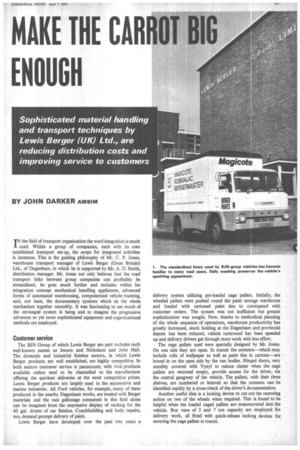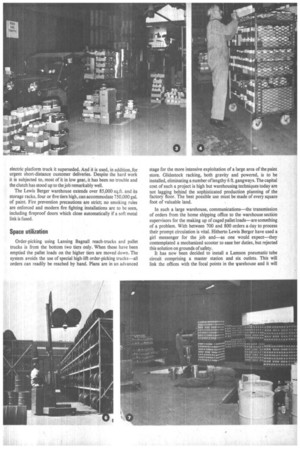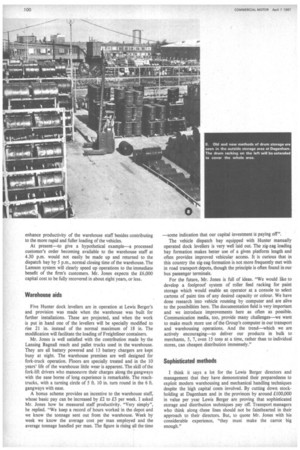Sophisticated material handling and transport techniques by Lewis Berger (UK) Ltd., are reducing distribution costs and improving service to customers
Page 99

Page 100

Page 101

Page 102

If you've noticed an error in this article please click here to report it so we can fix it.
BY JOHN DARKER AMBIFIA TN the field of transport organization the word integration is much used. Within a group of companies, each with its own established transport set-up, the scope for integrated activities is immense. This is the guiding philosophy of Mr. C. P. Jones, warehouse transport manager of Lewis Berger (Great Britain) Ltd., of Dagenham, in which he is supported by Mr. A. D. Smith, distribution manager. Mr. Jones not only believes that the road transport links between group companies can profitably be streamlined; he goes much further and includes within his integration concept mechanical handling appliances, advanced forms of automated warehousing, computerized vehicle routeing, and, not least, the documentary systems which tie the whole mechanism together smoothly. It was fascinating to see much of the envisaged system in being and to imagine the progressive advances as yet more sophisticated equipment and organizational methods are employed.
Customer service The BJN Group of which Lewis Berger are part includes such well-known names as Jenson and Nicholson and John Hall. The domestic and industrial finishes sectors, in which Lewis Berger products are well established, are highly competitive. In both sectors customer service is paramount; with rival products available orders tend to be channelled to the manufacturer offering the quickest deliveries at the most competitive prices. Lewis Berger products are largely used in the automotive and marine industries. All Ford vehicles, for example, many of them produced in the nearby Dagenham works, are treated with Berger materials and the vast gallonage consumed in this field alone can be imagined from the impressive display of racking for the 40 gal. drums of car finishes. Coachbuilding and body repairs, too, demand prompt delivery of paint.
Lewis Berger have developed over the past two years a delivery system utilizing pre-loaded cage pallets. Initially, the wheeled pallets were pushed round the paint storage warehouse and loaded with cartoned paint tins to correspond with customer orders. The system was not inefficient but greater sophistication was sought. Now, thanks to methodical planning of the whole sequence of operations, warehouse productivity has greatly increased, stock holding at the Dagenham and provincial depots has been reduced, vehicle turnround has been speeded up and delivery drivers get through more work with less effort.
The cage pallets used were specially designed by Mr. Jones. On one side they are open. In transit the contents—which may include rolls of wallpaper as well as paint tins in cartons—are boxed in on the open side by the van bodies. Hinged doors, very sensibly covered with Vynyl to reduce clatter when the cage pallets are returned empty, provide access for the driver, via the central gangway of the vehicle. The pallets, with their three shelves, are numbered or lettered so that the contents can be identified rapidly by a cross-check of the driver's documentation.
Another useful idea is a locking device to cut out the castoring action on two of the wheels when required. This is found to be helpful when the loaded caged pallets are manoeuvered into the vehicle. Box vans of 5 and 7 ton capacity are employed for delivery work, all fitted with quick-release locking devices for securing the cage pallets in transit. The Dagenham warehouse delivers to customers in London and the South East—broadly to the east of a line drawn from The Wash to Bournemouth. Depots at Bristol, Birmingham, Wigan, South Shields and Glasgow, all with their own road transport fleets, deal with regional orders. The provincial warehouses are supplied by 20-ton-capacity night trunk vehicles from Dagenham, with the exception of Glasgow supplies which are normally dispatched in a Freightliner container. The company operate their own trunk vehicles to Bristol and Birmingham but contractors' vehicles are currently doing the other trunk runs. The paint trade is seasonal, with a spring peak when tonnages from Dagenham can reach 900 tons per week.
Order processing
Starting with the Bristol office—the system will be progressively applied to other depots—a greatly improved ordering system has been introduced. An order from a Plymouth customer arriving by telephone or post at the Bristol depot in the morning is immediately transmitted to Dagenham where it is processed in time for the goods to be dispatched by a night trunk vehicle, making possible a next-day delivery.
Customer orders are received in the home shipping department where they are processed and allotted to the appropriate driver's round. At present, drivers are given discretion as to the order in which deliveries are made; some prefer to do their rounds in reverse order. But when, as is anticipated shortly, deliveries are planned by computer analysis, delivery sequences are likely to be more rigidly prescribed.
The Dagenham warehouse of Lewis Berger is separated from the paint factory by a main road. It is typical of the Company's approach to materials handling that the two premises are linked by tunnel bearing an automatic conveyor. Slave pallets attached to the 1,200 ft. long endless belt which circulates around the factory and warehouse can be readily detached or re-attached. The belt moves at 30 ft. per minute and completes a circuit every 40 minutes. The conveyor brings loads of filled paint tins to the warehouse and returns to the factory bearing sacks of dried pigment powders; liquid constituents are delivered direct to the factory.
Equally characteristic of the innovating approach is the use of a Minimoke as a tug for a 2-ton-capacity warehouse truck. This is faster, more manoeuvrable and costs no more to operate than the
electric platform truck it superseded. And it is used, in addition, for urgent short-distance customer deliveries. Despite the hard work it is subjected to, most of it in low gear, it has been no trouble and the clutch has stood up to the job remarkably well.
The Lewis Berger warehouse extends over 85,000 sq.ft. and its storage racks, four or five tiers high, can accommodate 750,000 gal. of paint. Fire prevention precautions are strict; no smoking rules are enforced and modern fire fighting installations are to be seen, including fireproof doors which close automatically if a soft metal link is fused.
Space utilization
Order picking using Lansing Bagnall reach-trucks and pallet trucks is from the bottom two tiers only. When these have been emptied the pallet loads on the higher tiers are moved down. The system avoids the use of special high-lift order-picking trucks—all orders can readily be reached by hand. Plans are in an advanced stage for the more intensive exploitation of a large area of the paint store. Glidestock racking, both gravity and powered, is to be installed, eliminating a number of lengthy 6 ft. gangways. The capital cost of such a project is high but warehousing techniques today are not lagging behind the sophisticated production planning of the factory floor. The best possible use must be made of every square foot of valuable land.
In such a large warehouse, communications—the transmission of orders from the home shipping office to the warehouse section supervisors for the making up of caged pallet loads—are something of a problem. With between 700 and 800 orders a day to process their prompt circulation is vital. Hitherto Lewis Berger have used a girl messenger for the job and—as one would expect—they contemplated a mechanized scooter to ease her duties, but rejected this solution on grounds of safety. It has now been decided to install a Lamson pneumatic tube circuit comprising a master station and six outlets. This will link the offices with the focal points in the warehouse and it will enhance productivity of the warehouse staff besides contributing to the more rapid and fuller loading of the vehicles.
At present—to give a hypothetical example—a processed customer's order becoming available to the warehouse staff at 4.30 p.m. would not easily be made up and returned to the dispatch bay by 5 p.m., normal closing time of the warehouse. The Lamson system will clearly speed up operations to the immediate benefit of the firm's customers. Mr. Jones expects the £6,000 capital cost to be fully recovered in about eight years, or less.
Warehouse aids Five Hunter dock levellers are in operation at Lewis Berger's and provision was made when the warehouse was built for further installations. These are projected, and when the work is put in hand one of the levellers will be specially modified to rise 21 in. instead of the normal maximum of 18 in. The modification will facilitate the loading of Freightliner containers.
Mr. Jones is well satisfied with the contribution made by the Lansing Bagnall reach and pallet trucks used in the warehouse. They are all battery powered and 13 battery chargers are kept busy at night. The warehouse premises are well designed for fork-truck operation. Floors are specially treated and in the 10 years' life of the warehouse little wear is apparent. The skill of the fork-lift drivers who manoeuvre their charges along the gangways with the ease borne of long experience is remarkable. The reachtrucks, with a turning circle of 5 ft. 10 in. turn round in the 6 ft. gangways with ease.
A bonus scheme provides an incentive to the warehouse staff, whose basic pay can be increased by £2 to £3 per week. I asked Mr. Jones how he measured staff productivity. "Very simply", he replied. "We keep a record of hours worked in the depot and we know the tonnage sent out from the warehouse. Week by week we know the average cost per man employed and the average tonnage handled per man. The figure is rising all the time -some indication that our capital investment is paying off".
The vehicle dispatch bay equipped with Hunter manually operated dock levellers is very well laid out. The zig-zag loading bay formation makes better use of a given platform length and often provides improved vehicular access. It is curious that in this country the zig-zag formation is not more frequently met with in road transport depots, though the principle is often found in our bus passenger terminals.
For the future, Mr. Jones is full of ideas. "We would like to develop a foolproof system of roller feed racking for paint storage which would enable an operator at a console to select cartons of paint tins of any desired capacity or colour. We have done research into vehicle routeing by computer and are alive to the possibilities here. The documentation field is very important and we introduce improvements here as often as possible. Communication media, too, provide many challenges—we want to make much more use of the Group's computer in our transport and warehousing operations. And the trend—which we are actively encouraging—to deliver our products in bulk to merchants, 5, 7, even 15 tons at a time, rather than to individual stores, can cheapen distribution immensely."
Sophisticated methods I think it says a lot for the Lewis Berger directors and management that they have demonstrated their preparedness to exploit modern warehousing and mechanical handling techniques despite the high capital costs involved. By cutting down stockholding at Dagenham and in the provinces by around £100,000 in value per year Lewis Berger are proving that sophisticated storage and distribution techniques pay off. Transport managers who think along these lines should not be fainthearted in their approach to their directors. But, to quote Mr. Jones with his considerable experience, "they must make the carrot big enough."
































































































































































